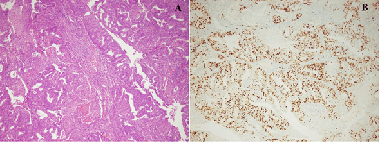The impact of Ki-67 index, squamous differentiation, and several clinicopathologic parameters on the recurrence of low and intermediate-risk endometrial cancer
DOI:
https://doi.org/10.17305/bjbms.2020.5437Keywords:
Low-intermediate risk, endometrioid endometrial carcinoma, recurrence, squamous differentiation, Ki-67Abstract
Endometrial endometrioid carcinoma (EEC) represents approximately 75-80% of endometrial carcinoma cases. Three hundred and thirty-six patients with EEC followed-up in the authors’ medical center between 2010 and 2018 were included in our study. Two hundred and seventy-two low and intermediate EEC patients were identified using the European Society for Medical Oncology criteria and confirmed by histopathological examination. Recurrence was reported in 17 of these patients. The study group consisted of patients with relapse. A control group of 51 patients was formed at a ratio of 3:1 according to age, stage, and grade, similar to that in the study group. Of the 17 patients with recurrent disease, 13 patients (76.5%) were Stage 1A, and 4 patients (23.5%) were Stage 1B. No significant difference was found in age, stage, and grade between the case and control groups (p > 0.05). Body mass index, parity, tumor size, lower uterine segment involvement, SqD, and Ki-67 index with p<0.25 in the univariate logistic regression analysis were included in the multivariate analysis. Ki-67 was statistically significant in multivariate analysis (p = 0.018); however, there was no statistical significance in SqD and other parameters. Our data suggest that the Ki-67 index rather than SqD needs to be assessed for recurrence in patients with low- and intermediate-risk EEC.
Citations
Downloads

Downloads
Additional Files
Published
How to Cite
Accepted 2021-02-10
Published 2021-02-18









